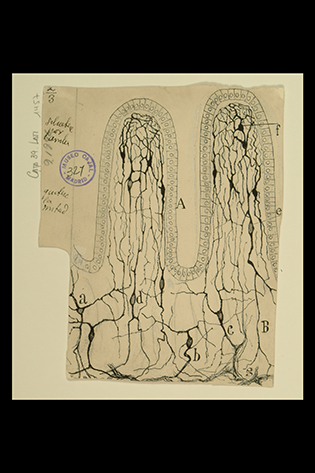Back Page
More Cajal on Campus

CREDIT: SANTIAGO RAMÓN Y CAJAL
This drawing of an olfactory bulb is one of seven newly arrived original drawings by Spanish scientist Santiago Ramón y Cajal, who shared the 1906 Nobel Prize in Physiology or Medicine in recognition of his work on the structure of the nervous system. This drawing and six others are on loan from the Cajal Institute (Madrid) and on display on the first floor of the Porter Neuroscience Research Center (Building 35) until the end of 2017. Two previous installations were on display for six months. Cajal, known as the father of modern neuroscience, was a prolific medical artist and produced hundreds of drawings depicting the organization of nerve cells in the brain.
Olfactory Bulb
The olfactory bulb transmits odorant information from nose to brain through six layers of neurons: the olfactory nerve layer (not shown), the glomerular layer (A), the external plexiform layer (B), the mitral cell layer (C), the internal plexiform layer (D), and the granule cell layer (E), which is deepest in towards the brain. Cajal definitively delineated the above six layers in 1890, building on earlier work by Schwalbe, and noted that scent information was not passed from single neuron to single neuron, as in other sensory systems, but was sent from the group of neurons comprising an olfactory fiber to multiple cells in the olfactory bulb.
Cajal was also the first to observe that scent signals are not necessarily transmitted in a serial manner; the mitral cells project into the glomerular layer and are in contact with some ends of the olfactory fibers, and their output is sent to structures deeper within the olfactory cortex. While he identified several types of cells present in the granule cell layer on a morphological and spatial basis, the function of these cells was not elucidated until recently: the provision of inhibitory feedback for mitral cells.
This page was last updated on Monday, April 11, 2022
